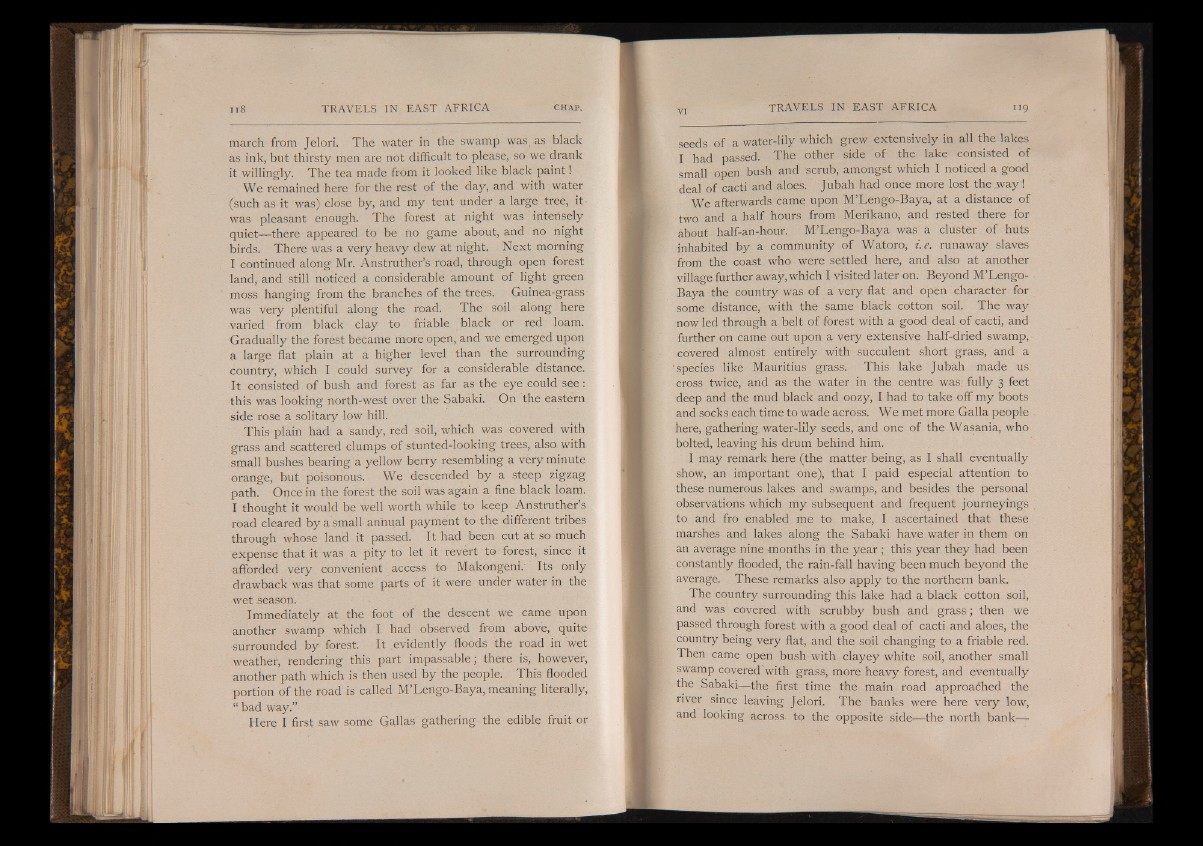
march from Jelori. The water in the swamp was, as black
as ink, but thirsty men are not difficult to please, so we drank
it willingly. The tea made from it looked like black paint!
We remained here for the rest of the day, and with water
(such as it was) close by, and my tent under a large tree, it-
was pleasant enough. The forest at night was intensely
quiet— there appeared to be no game about, and no night
birds; There was a very heavy dew at night. Next morning
I continued along Mr. Anstruther’s road, through open forest
land, and still noticed a considerable amount of light green
moss hanging from the branches of the trees. Guinea-grass
was very plentiful along the road. The soil along here
varied from black clay to friable black or red loam.
Gradually the forest became more open, and we emerged upon
a iarge flat plain at a higher level than the surrounding
country, which I could survey for a considerable distance.
It consisted of bush and forest as far as the eye could see:
this was looking north-west over the Sabaki. On the eastern
•side rose a solitary low hill.
This plain had a sandy, red soil, which was covered with
grass and scattered clumps of stunted-looking trees, alsa with
small bushes bearing a yellow berry resembling a very minute
orange, but poisonous. We descended by a steep zigzag
path. Once in the forest the soil was again a fine black loam.
I thought it would be well Worth while to keep Anstruther’s
road cleared by a small annual payment to the different tribes
through whose land it passed. It had been cut at so much
expense that it was a pity to let it revert to forest, since it
afforded very Convenient access to Makongeni. Its only
drawback was that some parts of it were under water in the
wet season.
Immediately at the foot of the descent we came upon
another swamp which I had observed from above, quite
surrounded by forest. It evidently floods the road in wet
weather, rendering this part impassable; there is, however,
another path which is then used by the people.. This flooded
portion of the road is called M’Lengo-Baya, meaning literally,
“ bad way.”
Here I first saw some GaUas gathering the edible fruit or
seeds of a water-lily which grew extensively in all the lakes
I had passed. The other side of the lake consisted of
small open bush and scrub, amongst which I noticed a good
deal of cacti and aloes. Jubah had once more lost the w a y !
We afterwards came upon M’Lengo-Baya, at a distance of
two and a half hours from Merikano, and rested there for
about half-an-hour. M’Lengo-Baya was a cluster of huts
inhabited by a community of Watoro, i.e. runaway slaves
from the coast who were settled here, and also at another
village further away, which I visited later on. Beyond M’Lengo-
Baya the country was of a very flat and open character for
some distance, with the same black cotton soil. The way
now led through a belt of forest with a good deal of cacti, and
further on came out upon a- very extensive half-dried swamp,
covered almost entirely with succulent short grass, and a
’species like Mauritius grass. This lake Jubah made us
cross twice, and as the wrater in the centre was. fully 3 feet
deep and the mud black and oozy, I had to take off my boots
and socks each time to wade across. We met more Galla people
here, gathering water-lily seeds, and one of the Wasania, who
bolted, leaving his drum behind him.
I may remark here (the matter being, as I shall eventually
show, an important one), that I paid especial attention to
these numerous lakes and swamps, and besides the personal
observations which my subsequent and frequent journeyings
to and fro enabled me to make, I ascertained that these
marshes and lakes along the Sabaki have water in them on
an average nine -months in the y ea r ; this year they had been
constantly flooded, the rain-fall having been much beyond the
average. These remarks also apply to the northern bank.
The country surrounding this lake had a black cotton soil,
and was covered with scrubby bush and grass; then we
passed through forest with a good deal of cacti and aloes, the
country being very flat, and the soil changing to a friable red.
Then came open bush with clayey white soil, another small
swamp covered "with grass, more heavy forest, and eventually
the Sabaki—the first time the main road approached the
river since leaving Jelori. The banks were here very low,
and looking across, to the opposite side— the north bank—